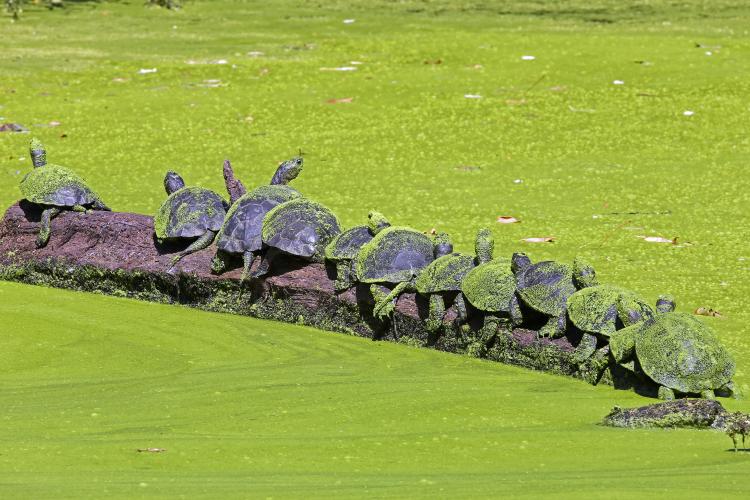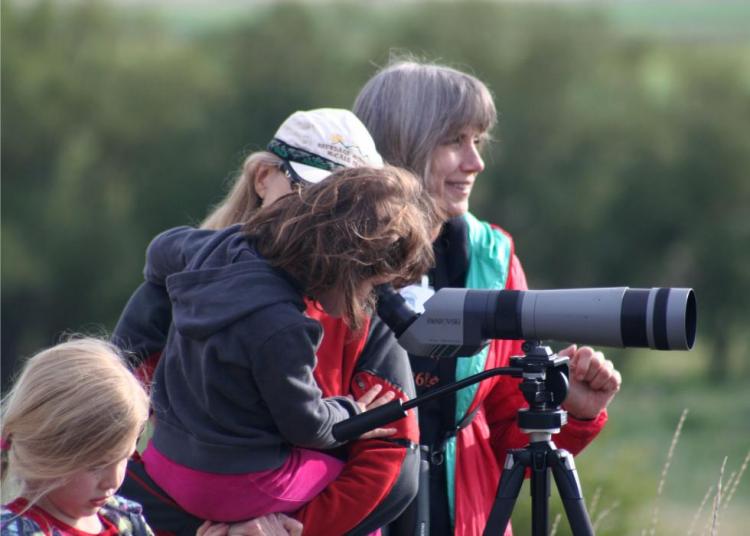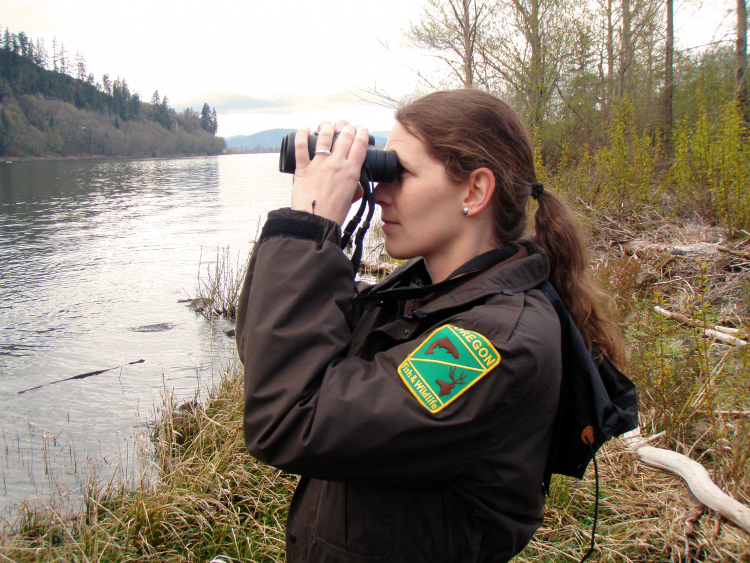Overview
The Oregon Conservation Strategy identifies priority Strategy Species and Strategy Habitats. These Strategy Species and Habitats should be monitored over time to determine their status and the effectiveness of applied conservation actions. Detailed guidance for monitoring is available and summarized for some Strategy Species and Strategy Habitats.
Importance of Monitoring
Investments in conservation should be strategic, effective, and accountable. Success of these investments can be measured by: (1) assessing existing conditions, (2) identifying desired conditions, and (3) measuring change over time.
A well-designed monitoring program takes an adaptive management approach using verifiable and reliable science. Monitoring objectives should be simple, easily communicated, and relevant to people’s concerns. Data and information derived from monitoring should be easily understood, well-documented, and accessible in a variety of formats for relevant audiences (e.g., scientists, public and private land managers, policy makers).
Role of Monitoring in Grants and Project Funding
Specific methodologies for monitoring and reporting monitoring results allow grant administrators and other funders to track specific progress and investment value of projects they have funded. This is especially helpful when tracking investments and projects that occur over wide areas and long periods of time.
Monitoring of conservation efforts or management actions should be funded along with any project implementation. Further, natural resource professionals should seek collaborative ways to make monitoring affordable, relevant, and easily accessible. Monitoring results should be shared with peers, policy makers, and local decision-makers to the extent possible, allowing people to learn about successes and adapt actions and policies more efficiently and strategically.

What to Monitor
It is not possible to monitor all species of potential conservation concern. Natural resource managers must consider the conservation goals and make reasoned, strategic decisions about monitoring needs. Priority is often placed on species or habitats in decline (Strategy Species and Habitats), or on locations that will potentially have the greatest impact to a number of conservation priorities simultaneously (Conservation Opportunity Areas).
Monitoring may occur at different scales: site, stream, watershed, ecoregion, and statewide. While different questions may be addressed and different variables measured at each scale, a monitoring plan should focus data collection on a clearly-defined purpose. Monitoring should be directed at the same scale that the conservation action or limiting factor is occurring. Results from local, site-specific monitoring projects should be incorporated into statewide, regional, national, and even international monitoring projects to allow for examination of larger-scale population or ecological trends. Project goals should outline what will be monitored, the appropriate monitoring approach, and for how long. Monitoring may be directed toward individual species or species groups, habitat conditions, ecological function, or ecological integrity.
Some key considerations when designing programs to monitor the status of Strategy Species and Strategy Habitats include:
- Monitoring efforts for Strategy Species should emphasize either species data gaps or limiting factors at appropriate spatial scales. Depending on the existing knowledge base, species monitoring may need to focus on collecting data regarding:
- Range and distribution
- Population status and trends (at various scales)
- Life history traits
- Response to particular types of habitat management or human activity
- Effects of Key Conservation Issues
- Specific limiting factors (e.g., the degree of contaminants in fish found in the lower Columbia River).
- For long-term monitoring efforts, emphasize Strategy Species or Strategy Habitats and/or support regional, west-wide, or national programs
- Incorporate Strategy Species monitoring into other monitoring efforts

Monitoring Strategies
Conservation Strategy monitoring can focus on (1) species, sometimes called the “fine filter for conservation planning” or (2) habitats or other environmental measurements, sometimes called the “coarse filter for conservation planning”. Specific examples are described below.
Species Monitoring
| What to Monitor | Why Monitor? | Example Efforts |
|---|---|---|
| Strategy Species | Determine the current presence and distribution of species as well as demographic information, such as population status and/or trends. | The Oregon Biodiversity Information Center maintains observation and occurrence records for species with conservation status.
The Breeding Bird Survey monitors status and trends of North American bird populations. |
| Indicator Species | Monitoring indicator species provides information about changes in the characteristics of an environment (e.g., habitat, ecoregion). To be a good indicator, a species needs to be relatively common, occur frequently enough to be monitored, and respond to certain actions or represent a desired condition. Strategy Species often are not appropriate as indicator species because they are generally not common and often require specialized habitat. | Partners in Flight Western Working Group
Working with the Oregon Department of Fish and Wildlife and other partners, the Klamath Bird Observatory developed a Species Monitoring Portfolio to support Strategy monitoring. |
| Surrogate Species | Surrogate species are intended to represent a suite of species or a particular habitat type. Monitoring a surrogate species provides information that can then be used to infer trends or conditions of multiple species. Surrogate species are not necessarily “common” species. | The U.S. Fish and Wildlife Service Surrogate Species Initiative is identifying surrogate species for each Strategy Habitat in every ecoregion across Oregon. |
Habitat and Ecological Indicator Monitoring
| What to Monitor | Why Monitor? | Example Efforts |
|---|---|---|
| Strategy Habitats | Assess habitats over time and provide details on habitat conditions, trends, changes in extent, responses to treatments, invasive species, and many other variables. | SageCON |
| Aquatic and Watershed Monitoring | Helps ensure good water quality and healthy watersheds, which are essential for many species and ecological functions. | The National Fish Habitat Action Plan provides a national framework for assessing aquatic habitat quality.
The Oregon Watershed Restoration Inventory tracks voluntary efforts to restore watersheds for salmon and wildlife. |
| Ecological Indicators | Represent valued ecological attributes and can help determine if an impact exists. | U.S. EPA Ecological Indicators |
Monitoring Guidance
Strategy Species Monitoring Guidance and Resources
Strategy Species pages provide information on species-specific survey efforts and monitoring guidance documents.
Scientific Taking Permit Requirements
In Oregon, Scientific Taking Permits are required by the Oregon Department of Fish and Wildlife (ODFW) when fish or wildlife will be captured or handled for scientific purposes. Depending on the species, federal permits may be required as well.
Bird Monitoring
- Waterfowl management plans (Pacific Flyway Council Management Plans)
- Information on population trends from annual monitoring reports:
- U.S. Fish and Wildlife (USFWS) Annual Reports
- U.S. Geological Survey (USGS) Waterbird Monitoring Manual
- Shorebird Monitoring Plans
- Breeding Bird Survey
- Resources for Landbirds
- U.S. Department of Agriculture (USDA) Handbook of Field Methods for Monitoring Landbirds
- USFWS Guide to Statistical Analysis of Data from Avian Monitoring Projects
- Landbird Monitoring Strategy for Oregon and Washington, Version 1.0, October 2011 (Partners in Flight, Klamath Bird Observatory)
- A Directory of Landbird Monitoring and Assessment Projects in Oregon and Washington (Partners in Flight)
- Inventory Methods for Raptors, Version 2.0 (Standards for Components of British Columbia’s Biodiversity No. 11), October 2001
- Multiple Species Inventory and Monitoring Technical Guide, Version 1. (Chapters 3 and 4) USDA Gen. Tech. Report WO-73, August 2006
- USFWS Raptor Guidelines in the Western U.S., February 2008
- Monitoring Animal Populations and their Habitats: A Practitioner’s Guide
Mammal Monitoring
- Multiple Species Inventory and Monitoring Technical Guide, Version 1. (Chapters 5, 6, & 7) USDA Gen. Tech. Report WO-73, August 2006
- Measuring and Monitoring Biological Diversity: Standard Methods for Mammals. F.R. Wilson, J.D. Nichols, R. Rudran, and M.S. Foster, editors. Smithsonian Institution Press, Washington, DC. Pp. 115-155.
Amphibian and Reptile Monitoring
- USGS Amphibian Research & Monitoring Initiative
- Partners for Amphibian & Reptile Conservation: Inventory and Monitoring: Recommended Techniques for Reptiles and Amphibians, with Application to the United States and Canada. G.J. Graeter, K.A. Buhlmann, L.R. Wilkinson, and J.W. Gibbons, editors.
- Multiple Species Inventory and Monitoring Technical Guide, Version 1. (Chapter 8) USDA Gen. Tech. Report WO-73, August 2006
- Sampling Methods for Terrestrial Amphibians and Reptiles. 1990. USDA Gen. Tech. Report PNW-GTR-256.
- Sampling Amphibians in Lentic Habitats. 1997. Northwest Fauna No. 4: Society for Northwestern Vertebrate Biology.
- Measuring and Monitoring Biological Diversity: Standard Methods for Amphibians. 1994. W.R. Heyer, M.A. Donnelly, R.W. McDiarmid, L.C. Hayek, and M.S. Foster. Smithsonian Institution Press, Washington, DC.
- Western Pond Turtle: Biology, Sampling Techniques, Inventory and Monitoring, Conservation, and Management. 2012. Northwest Fauna No. 7. Society for Northwestern Vertebrate Biology.
Fish Monitoring
- The ODFW monitors fish species and their habitat across the state. The ODFW Corvallis Research Laboratory website has a variety of project-specific information, including protocols, guidance (habitat), reports and publications, and data. Additional data are available through the ODFW Data Clearinghouse.
- The ODFW Salmon and Steelhead Recovery Tracker website provides information on the health of Oregon’s anadromous salmon and steelhead populations. Website users can explore and download information related to salmon conservation and recovery in Oregon, including metadata explaining how data were collected and analyzed.
- Pacific Northwest Aquatic Monitoring Partnership (PNAMP) gathers information and resources on monitoring of fish, habitat, and water quality. PNAMP’s Resources page provides a network of information and tools to support many facets of ecological and biological monitoring, including orientation and educational materials, a community forum, a place to document and share monitoring methods, the ability to describe monitoring projects and upload sample sites, and tools for creating sample designs.
General Monitoring Resources (including invertebrates and plants)
- The U.S. Forest Service’s (USFS) Interagency Special Status and Sensitive Species Program lists references for inventory and monitoring protocols for many sensitive species, including butterflies and moths, snails and slugs, amphibians, birds, bats, plants, and fungi.
Watershed and Effectiveness Monitoring
- The Oregon Plan for Salmon and Watersheds monitoring program provides technical assistance manuals produced by the Oregon Watershed Enhancement Board (OWEB) and manuals developed by the Oregon Department of Environmental Quality to guide water quality monitoring. These are good sources for launching monitoring programs and for guidance on effectiveness monitoring.

Citizen Science
Citizen-based monitoring can greatly expand our ability to collect data. Through citizen science, Oregonians contribute valuable local biological knowledge. For example, birdwatchers and anglers understand the distribution and behavior of their favorite species, and farmers and other landowners have deep familiarity with what occurs on their land. Citizen-based monitoring can tap into this knowledge, increase the amount of data that can be collected, and reduce the overall costs of data collection. Citizen-based monitoring also engages Oregonians to take an active part in conservation, teaching people about their local environment, and providing a forum for feedback and discussions related to conservation actions currently underway on their land or in their neighborhood.
By supporting and building on these efforts, scientists and Oregonians can work together to address monitoring priorities identified in the Strategy.
Examples of Ongoing Citizen Science Efforts in Oregon
| Citizen Science Project | Location |
|---|---|
| North American Breeding Bird Survey | International |
| eBird | International |
| North American Bird Phenology Program | National |
| Christmas Bird Count:Portland metro area, Statewide, National | Local, regional, and national |
| Fourth of July Butterfly Count | Oregon |
| Whale Watching Spoken Here | Oregon Coast |
| Dragonfly Migration Monitoring | North America |
| Journey North | International |
| Oregon Master Naturalist Program | Adult education program on Oregon’s natural history and natural resources |
| Alliance of Natural Resource Outreach and Service Programs | Information on Master Naturalist programs throughout the U.S. |
| iNaturalist | International |
Citizen Science Resources
- CitizenScienceAlliance.org: “A collaboration of scientists, software developers, and educators who collectively develop, manage, and utilize internet-based citizen science projects in order to further science itself, and the public understanding of both science and of the scientific process. These projects use the time, abilities, and energies of a distributed community of citizen scientists who are our collaborators.”
- National Wildlife Federation (NWF): Maintains a citizen science hub that provides resources to NWF programs, including Wildlife Watch, which collects wildlife observations. “Citizen science is where the public volunteers time to assist scientists in their research. Citizen scientists can support professional researchers in a lot of ways – by submitting data, sharing experiences, or spreading valuable information. Scientists benefit from having a lot more data to analyze and a pool of volunteers willing to help.”
- eBird.org: “Providing global tools for birders, critical data for science. Record the birds you see. Keep track of your bird lists. Explore dynamic maps and graphs. Share your sightings and join the eBird community. Contribute to science and conservation.”
- iNaturalist: Online space to record natural history observations, interact, and learn
- Journey North: Global study of wildlife migration and seasonal change
Data Management
A critical component of any monitoring program is effective data management. Quality data are needed to evaluate the effects of conservation actions on species and habitats, and make appropriate adjustments, if necessary. Some important first steps for data management include:
- Identifying critical data management needs early in the monitoring project planning phases. Data collection activities should not begin until a proper database design (data dictionary) and data management plan is developed.
- At minimum, a data management plan should include:
- Database design, including investigating data standards or protocols for data being collected
- Plans for metadata (data documentation) development
- Plans for data distribution (incorporate local data in larger scale, regional efforts; provide data access through online functionalities; etc.)
Data Management Resources
- ODFW’s Natural Resources Information Management Program: provides data and metadata standards for ODFW staff, and the ODFW Data Clearinghouse
- Oregon Department of Administrative Services Geographic Enterprise Office: provides statewide data management and GIS resources, including the Oregon Spatial Data Library
- Data.gov: access all federally managed open data, including USFWS, USFS, and Bureau of Land Management
- NatureServe data management tool Biotics 5: methodology and data standards for species-related tabular datasets
Tracking and Reporting Results
Monitoring the effectiveness of conservation actions and adapting these actions to respond appropriately to new information or changing conditions requires that results be tracked and reported. The following steps should continue to be considered by agencies, the Oregon Biodiversity Information Center, the OWEB, and other partners:
- Identify how progress will be measured (e.g., specific metrics to be used, such as number of acres restored, number of stream miles improved, or number of landowners given technical assistance).
- Implement consistent procedures for data entry so that progress reporting can be done through queries to a database. Where possible, develop tools to automate the reporting process.
- Design web-based data tools to ensure consistent data entry by multiple partners, maintain data integrity, and improve data sharing.
Using Monitoring Results
Adaptive Management
Use monitoring results to determine the conservation outcomes of a project and to identify adaptive management strategies. Natural resource managers must continuously learn from their efforts to restore habitat and implement conservation actions. Management of projects and funds can then be adapted based on new information and/or changing conditions. However, adaptive management is not just trial and error. It is a process that adjusts active management by determining which actions work, and analyzing why they succeed or fail. Steps include: Assess – Plan – Implement – Monitor – Learn – Adapt – Repeat, and more information is available through the USGS Adaptive Management Guide.
Effectiveness Monitoring
Effectiveness monitoring is designed to determine if the project is effective at meeting its biological and ecological objectives. More information on effectiveness monitoring is available through the OWEB’s Effectiveness Monitoring page.
Species or habitat variables should be monitored over time to determine project effectiveness. Adaptive management approaches should be used if new approaches are needed to meet project goals.
Tracking Conservation Efforts
Providing mapped locations of conservation projects allows land managers to allocate resources more efficiently and reduce duplication of efforts. Over time, tracking projects on the ground allows managers to evaluate the cumulative progress towards conservation goals for Strategy Species and Strategy Habitats.
Example Resources to Track Conservation Efforts for Strategy Priorities
| Resource | Explanation |
|---|---|
| Conservation Registry | Landscape-scale conservation project mapping tool. Tracks and maps conservation, restoration, and wildlife projects across the U.S. Developed by Defenders of Wildlife, the Oregon Department of Fish and Wildlife, and other partners to support the Strategy and to facilitate informed decision-making, inspire collaboration, and provide context and effectiveness for conservation work. |
| Wildlife Tracking and Reporting Actions for the Conservation of Species (TRACS) | Wildlife TRACS is the tracking and reporting system for conservation and related actions funded by the U.S. Fish and Wildlife Service’s Wildlife and Sport Fish Restoration Program. View project reports or view project locations on an interactive map. |
| Results Chain Models
Teaming with Wildlife provides information on how other states are using Results Chain Models in State Wildlife Action Plans. |
Develop performance measures for wildlife management activities. Define project outcomes and show the connection between management actions and conservation outcomes for Species of Greatest Conservation Need (Strategy Species). |
